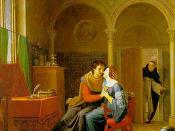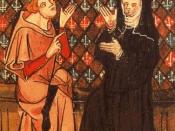The letters of Abelard and Heloise, illustrate a shift away from religious teachings. Abelard lived during a period of scholasticism (1079-1122), a time focused on philosophy and dialectic. Theology, for the first time was considered an individual discipline. Other changes during the period included divisions of faculty, a movement away from monasteries as the only places of education, and a contrast between reason and faith. Particularly important to Abelard was the distinction between reason and faith. In his letters to Heloise, Abelard finds faith unnecessary, instead he uses reason as a tool to understanding the questions of life. In his letters we find a transition from a focus on religious works and learning to secular knowledge.
Scholasticism placed learning and knowledge above all else. The period influenced and transformed past customs and culture. "I preferred the weapons of dialectic to all the other teaching of philosophy, and armed with these I chose the conflicts of disputation instead of trophies of war."
Here we see a shift from the body as a source of power to the mind. A new sort of higher education emerged creating seven liberal areas of study. One of these seven included "logic." For Abelard, logic served as "an instrument of order in a chaotic world." Furthermore, Abelard was certain logic could be applied to all the "fields of thought" and should dominate ones life. Another important change was from monastic schooling to Cathedral schools. The significance of this transition was the development of universities. Disputation, a new method of teaching, replaced traditional lectures and theology became an important focus.





